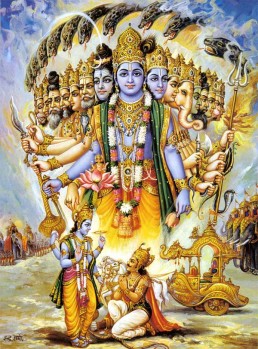Swami Chinmayananda
Swami Chinmayananda Commentary
Again from the luxurious chambers of riches and splendour, the students of the Geeta are lifted, on the lyrical charm of the poem, to the humming ground of the battle-field and to the Wonder-Form of the Lord. The picture of Arjuna addressing the Lord with his hands folded, trembling with fear, singing songs of adoration, with a throat chocked with fear and wonderment is effectively drawn. This passage, containing the following ELEVEN stanzas, represents one of the most beautiful prayers that we have in Hinduism. In fact, the words and the ideas expressed hereunder are so general in their import and significance that we can almost say that no better Universal Prayer can ever be conceived of, either in its concept, beauty, or cadence, or in the depth of the message in its words.
In these passages, the cognising power in Arjuna is steadily realising the diviner Truth behind the details of that Total-Form. When one watches and sees one’s own reflection in a mirror, it is rarely that the observer sees the mirror-surface. When one watches the surface of the mirror, the reflection is either not at all available or, at best is only dimly recognised. So long as Arjuna is preoccupied with the details of the Universal-Form, he does not realise, or recognise, the Infinite which is the very core of the Vishwaroopa. In these passages, it is evident that Arjuna has started sensing the deeper meaning that lies behind the cosmic wonder represented to him in his vision Divine.
Adi Sankara Commentary
Sthane, it is proper; -what is that?-that the jagat, world; prahrsyati, becomes delighted; tava prakirtya, by Your praise, by reciting Your greatness and hearing it. This is befitting. This is the idea. Or, the word sthane may be taken as qualifying the word ‘subject’ (understood) : It is proper that the Lord is the subject of joy etc. since the Lord is the Self of all beings and the Friend of all. So also it (the world) anurajyate, becomes attracted, becomes drawn (by that praise). That also is with regard to a proper subject. This is how it is to be explained. Further, that the raksamsi, Raksasas; bhitani, stricken with fear; dravanti, run; disah, in all directions-that also is with regard to a proper subject. And that sarve, all; the siddha-sanghah, groups of the Siddhas-Kapila and others; namasyanti, bow down-that also is befitting. He points out the reason for the Lord’s being the object of delight etc.:
The Bhagavad Gita with the commentary of Sri Sankaracharya – Translated by Alladi Mahadeva Sastry
Holy Geeta – Commentary by Swami Chinmayananda
The Bhagavad Gita by Eknath Easwaran – Best selling translation of the Bhagavad Gita
The Bhagavad Gita – Translation and Commentary by Swami Sivananda
Bhagavad Gita – Translation and Commentary by Bhaktivedanta Swami Prabupadha
Srimad Bhagavad Gita Chapter 11 – Verse 36 – 11.36 sthane hrsikesa – All Bhagavad Gita (Geeta) Verses in Sanskrit, English, Transliteration, Word Meaning, Translation, Audio, Shankara Bhashya, Adi Sankaracharya Commentary and Links to Videos by Swami Chinmayananda and others – 11-36

